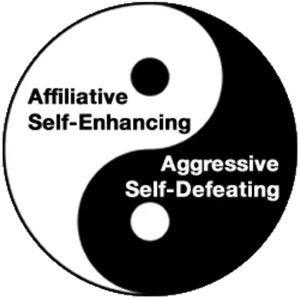1.5 Wist u dat?
- Laughter is a universal language, transcending cultural and linguistic barriers.
- Although often associated, laughter and humor however are different events.
- Laughing “at” pushes away. Laughing “with” brings closer.
Op deze pagina:
- The Psychophysiological Perspective: Laughter As A Response | Laughter As A Choice
- The Energy Perspective: Vertical Vs. Horizontal | May I Be Frank | Laughter In The Bible | Silly Vs. Playful
Binnen "Klik hier om meer te leren“
It’s time to clarify a few things about laughter.
Doing so is important because how you think about something dramatically impacts how you engage with it.
There are two different angles from which we can look at laughter:
- The psychophysiological perspective looks at the mechanics of it.
- The energy perspective looks at the intention we put behind it.
Laughter As A Response
Laughter as a response falls into one of 4 categories:
 1. Spontaneous laughter is triggered by different favorable stimuli that can be external (e.g., humor, human interactions) or internal (e.g., positive emotions, pleasant thoughts). This is how most people see and understand laughter: If something happens, then I will laugh (or not). Although often associated, laughter and humor however are different events. You can experience humor (a stimulus) without laughter and laughter (a choice, emotion, or a response) without humor. Humor requires high brain functions (right frontal cortex, medial ventral prefrontal cortex, the right and left posterior temporal regions, and possibly the cerebellum), which is why it varies considerably between ages, genders, cultures, etc. What is funny to some is not funny at all to others.
1. Spontaneous laughter is triggered by different favorable stimuli that can be external (e.g., humor, human interactions) or internal (e.g., positive emotions, pleasant thoughts). This is how most people see and understand laughter: If something happens, then I will laugh (or not). Although often associated, laughter and humor however are different events. You can experience humor (a stimulus) without laughter and laughter (a choice, emotion, or a response) without humor. Humor requires high brain functions (right frontal cortex, medial ventral prefrontal cortex, the right and left posterior temporal regions, and possibly the cerebellum), which is why it varies considerably between ages, genders, cultures, etc. What is funny to some is not funny at all to others.
2. Stimulated laughter happens as a result of the physical contact or action (reflex) of certain stimuli (e.g., someone tickles you). For tickling to work, the brain needs tension and surprise, but how the brain uses this information is still a mystery. Tickling is usually a source of embarrassment when practiced with strangers and can easily turn into a form of aggression even with people you know and care for.
3. Induced laughter is of a chemical nature, e.g., by inhaling laughing gas (nitrous oxide). It has its uses in clinical settings but is not recommended for recreational purposes because it can have nasty consequences;
4. Pathological Laughing and Crying (PLC) is often associated with crying and tends to be uncontrollable and excessive. PLC is a relatively frequent consequence of brain damage when not resulting from neurologic illnesses. It has been reported that the prevalence of PLC is approximately 10-20% among patients with stroke, 40% among patients with Alzheimer’s disease (AD), 7-10% among patients with multiple sclerosis, and 19-49% among patients with amyotrophic lateral sclerosis (ALS). The duration of laughter episodes is usually short (i.e., less than a minute) but may last as long as an hour or until the patient is exhausted.

Laughter As A Choice
This is a category of its own and the one we will work within this course. Here, laughter can be either simulated (forced, faked, mechanically practiced) or intentional (chosen, allowed). Either way, it is self-induced and triggered by oneself at will. Laughter in this category offers five important benefits over the random laughter of daily life:
1. It’s easier. Unlike other modalities, which are more time-consuming, committed, or expensive, laughter-based programs are easy to implement and require no particular space, equipment, or form of clothing. You don’t need to have a sense of humor or any justification. As long as someone is willing to laugh, the only limitations to the practice are physical abilities and stamina.
2. It is reliable. You can plan ahead of time where, when, how, and how long you are going to laugh. The only two reasons it may not work are if someone does not understand the instructions or doesn’t want to do it.
3. It is sustainable. Laughter attracts us because it’s a human need and something we are naturally wired to do and enjoy doing. People never get bored with intentional laughter because, in essence, it’s free of condition and, therefore, always new, fresh, and different.
4. Het is universeel, toegankelijk en direct beschikbaar. We can all choose to laugh like we can choose to believe that we can’t, yet the fact remains that humans are naturally wired for laughter. Laughter begins as an uncontrollable reflex when babies reach about four months of age. First, we laughed, then we talked.
5. It’s a valid alternative. Imagine cutting a lemon in half and squeezing it in your mouth. How do you feel? The more vividly you imagine this experience, the stronger your body will react. Your mind knows there is no lemon, but your body doesn’t. This illustrates an intricate relationship between our body and brain; it is possible to simulate something with one to stimulate something in the other.

Vertical Vs. Horizontal
From an energy perspective, you can laugh as you direct your energies upwards (vertical) or sideways (horizontal), leading to very different outcomes.
 Vertical: This is about laughing with, focusing, and moving toward what we want rather than away from what we don’t want, and exploring healthy ways to cope with stress, fostering a sense of inclusion, flow, and gratitude for life, fellowship, happiness, and well-being; celebrating life and sharing the best of ourselves.
Vertical: This is about laughing with, focusing, and moving toward what we want rather than away from what we don’t want, and exploring healthy ways to cope with stress, fostering a sense of inclusion, flow, and gratitude for life, fellowship, happiness, and well-being; celebrating life and sharing the best of ourselves.
Horizontal: This is about laughing at, moving away from, and implies a sense of disconnection. It’s about making fun of self or others in a way that diminishes, takes something away, or makes “it” look bad or worse off by implying the existence of something better and more desirable, e.g., “I have the power to make you laugh, which means I’m better than you are.” Horizontal laughter is typically associated with sad clown syndrome. It may involve put-downs, insults hidden behind the cloak of humor, or making oneself the butt of jokes in an aggressive or “poor me” fashion. When it is intended to threaten or psychologically harm others, it is the type of laughter (typically humor) used by bullies.
May I Be Frank
Here is a video that, to me, illustrates well this difference between vertical and horizontal laughter. Meet Frank, a 54-year-old man who loved to laugh and make others laugh. Yet the jokes were on him, all self-deprecating. The truth is, Frank hated himself.
Laughter In The Bible
This energy perspective on laughter is also well illustrated in the Bible, of all places:
- It includes twenty-one references to the laughter of fools, of ridicule, or of being a laughing stock. E.g., Luke 8:53 – They laughed at him, knowing she was dead.
- It includes eleven references to laughter as an expression of strength and fearlessness. E.g., Luke 6:21 – Blessed are you who hunger now, for you will be satisfied. Blessed are you who weep now, for you will laugh.
- It includes six references to laughter as a celebration or expression of joy. E.g., Job 8:21 – He will yet fill your mouth with laughter and your lips with shouts of joy.
The point here is that, like with knives, fire, or so many other things, laughter can be of tremendous value to humanity… or very detrimental, and it all depends on how we choose to use it. Please do not blame the tool for how it is used. Therefore, watch not the laughter but the energy behind it: Is it a laughter of separation or inclusion? Is it to celebrate or to ridicule? Are you laughing at or with others? Are you laughing to move away from pain or to get closer to joy? To negate the experience of laughter because you believe you are a sinner or that it is a sign of frivolity is what keeps you a sinner in a world of darkness.
There is more. This energy perspective on laughter manifests itself in words as well.
Silly vs. Playful
Let’s look at silly vs. playful, for example.
It is common for people to confuse intentional laughter with something forced, faked, acting silly, or childish.
Making a substantial distinction between these terms is essential because how you understand and perceive your behaviors impacts the energies you place behind them, which modulates how you act and interact with others. At stake is how this dynamic affects your self-image.
“Silly” and “childish” are labels on a judgment scale. From a cultural standpoint, they are derogatory terms that define having or showing a lack of common sense or judgment as absurd and foolish. No matter your definition of those words, society will always have the last word and impose its own.
On the other hand, playful and childlike describe a state of being. They are a giving and the manifestation of a feeling of joy. They have a beginning and an end and mean nothing. They don’t take anything away and laugh “with.”
Understand that this is not a call to modify any behavior but rather an invitation to reconsider why you laugh when you do. A playful or childlike approach to everyday things is crucial to staying healthy. Daily chores are less burdensome when we laugh while doing them. We aren’t always having fun, but we have much more fun with laughter than without.
What this means in practice:
1. This is wonderful if wearing a clown nose, funny wigs, or any other prop makes you laugh. Keep wearing them. Just don’t label yourself as “silly” in your head. Wear them because you like them, they make you feel good, and you would be equally entertained if you were the only one to ever know about them. Make it fun. Please do it for yourself, not because you think it will make others laugh. The only way to tap into laughter’s more profound benefits is to do it for you with others and not for them.
2. Always laugh “with” others, never “at” them.

 Bedankt voor je interesse in ons trainingsprogramma! De rest van deze pagina maakt deel uit van de exclusieve, premium inhoud die beschikbaar is voor degenen die ervoor kiezen hun ervaring te upgraden. Schrijf u in op onze wachtlijst om als een van de eersten toegang te krijgen wanneer we officieel lanceren! Als blijk van onze waardering bieden we een tijdelijke introductiekorting aan voor onze early adopters.
Bedankt voor je interesse in ons trainingsprogramma! De rest van deze pagina maakt deel uit van de exclusieve, premium inhoud die beschikbaar is voor degenen die ervoor kiezen hun ervaring te upgraden. Schrijf u in op onze wachtlijst om als een van de eersten toegang te krijgen wanneer we officieel lanceren! Als blijk van onze waardering bieden we een tijdelijke introductiekorting aan voor onze early adopters.